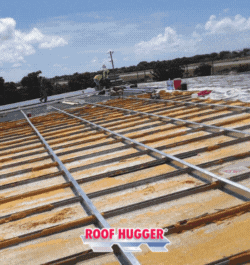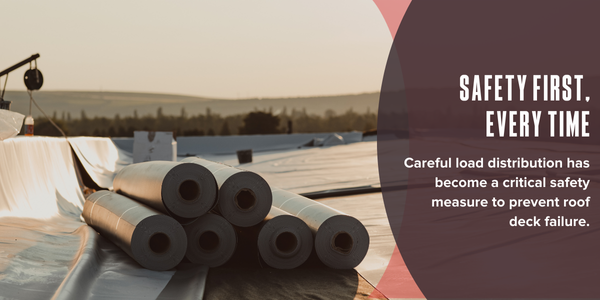UP TO THE MINUTE
Safety first, every time
October 18, 2025 at 6:00 a.m.By Dani Sheehan.
As materials evolve and rooftops become more crowded, careful load distribution has become a critical safety measure to prevent roof deck failure.
In a recent Contractor Outlook Newscast, Heidi J. Ellsworth sat down with Mark Graham, vice president of technical services for the National Roofing Contractors Association (NRCA), to discuss a challenge that’s too often overlooked: roof weight safety. While collapses may be rare, the risks are increasing as materials get heavier and building rooftops host more equipment than ever before.
“There really isn’t a standard practice for how we load a roof in a re-roofing job or even how we perform inspections before starting,” Mark explained. “That’s something the industry needs, but we’re not there yet.”
Even so, there are steps you can take right now to protect your crews, your projects and the buildings you work on.
1 – Own the roof
Roofing professionals should take the lead when it comes to protecting rooftop real estate. “At a minimum, the roofing contractor doing maintenance deserves a phone call if another trade is going up there,” Mark shared. Other trades frequently work on projects in tandem with roofers, adding equipment and weight to the roof without considering structural limits. As the maintenance provider, you can assert your role as lead and prevent unmonitored additions to ensure safety is evaluated before new loads are introduced.
2 – Insist on interior access
One of the biggest safety gaps occurs when contractors start work without inspecting the interior of the building, usually at the request of the building owner or facility manager. Skipping this step makes it impossible to spot signs of leaks, deterioration or past structural repairs.
“We have to change that mindset,” Mark emphasized. “Instead of climbing the ladder first, we need to go inside and look around. And if we don’t get interior access, we should be willing to pass on the job. It’s not worth the risk.” This shift gives contractors a full understanding of what they’re working with to ensure their own safety before adding significant material loads to the roof.
3 – Rethink roof loading practices
Roofing materials today are shipped in heavier, bulkier packages than they used to be. A single pallet of roll goods or cover board can weight up to 2,500 pounds, while a pallet of single-ply membranes can top 3,500 pounds. When concentrated in one area, these loads can easily exceed what the roof deck was designed to carry.
Mark shared, “It makes a difference where and in what orientation a pallet is set on the roof.” Simply rotating a pallet so that its weight is spread across multiple bar joists, rather than concentrated on decking, can reduce the risk of failure. Take the few extra minutes to carefully plan roof loading, distributing weight strategically rather than stockpiling materials in one corner of the roof.
Listen to the full podcast episode to gain more insights on the importance of roof weight safety.
Learn more about National Roofing Contractors Association (NRCA) in their Coffee Shop Directory or visit www.nrca.net.

About Dani
Dani is a writer for The Coffee Shops and AskARoofer™. When she's not writing or researching, she's teaching yoga classes or exploring new hiking trails.
Recommended For You

Simplifying the metal building experience
Read More ...
Turbocharging contractor success
Read More ...
Across the pond
Read More ...
















Comments
Leave a Reply
Have an account? Login to leave a comment!
Sign In